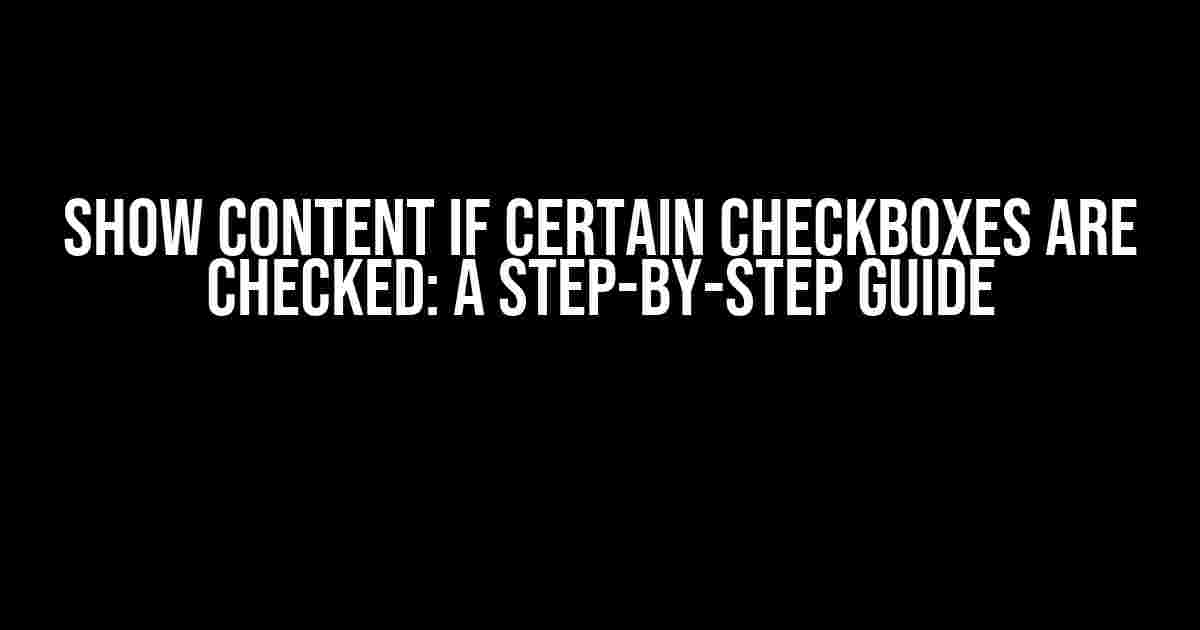Welcome to this comprehensive guide on how to show content if certain checkboxes are checked! Are you tired of cluttered interfaces and wanting to give your users a more personalized experience? Look no further! In this article, we’ll take you through the process of creating a dynamic interface that reveals hidden content based on user input.
Why Show Content Based on Checkbox Selection?
In today’s digital age, user experience is key. By tailoring your interface to individual user preferences, you can increase engagement, reduce bounce rates, and even improve conversions. But how do you achieve this? The answer lies in conditional logic, and that’s where checkboxes come in.
The Power of Checkboxes
Checkboxes are an essential component of modern web design. They allow users to select multiple options from a list, making them perfect for creating customizable interfaces. But what if you want to take it a step further? What if you want to show specific content based on the checkboxes users select?
That’s where we come in. In this article, we’ll explore the different methods of showing content based on checkbox selection. From JavaScript and CSS to HTML and APIs, we’ll cover it all. So, grab your favorite snack, get comfortable, and let’s dive in!
Method 1: Using CSS to Show Content
One of the simplest ways to show content based on checkbox selection is by using CSS. Yes, you read that right – CSS! With the power of CSS, you can create a seamless user experience without writing a single line of JavaScript.
/* HTML */
This content is hidden until checkbox-1 is checked
/* CSS */
.hidden-content {
display: none;
}
#checkbox-1:checked ~ .hidden-content {
display: block;
}
In the above example, we use the `:checked` pseudo-class to target the checkbox. When `#checkbox-1` is checked, the adjacent `.hidden-content` element is displayed. This is achieved using the `~` combinator, which selects siblings that come after the checkbox.
Method 1.1: Using CSS to Show Content with Multiple Checkboxes
But what if you have multiple checkboxes and want to show content based on a combination of selections? Fear not, dear reader, for CSS has got you covered!
/* HTML */
This content is hidden until checkbox-1 and checkbox-2 are checked
/* CSS */
.hidden-content {
display: none;
}
#checkbox-1:checked ~ #checkbox-2:checked ~ .hidden-content {
display: block;
}
In this example, we use the `:checked` pseudo-class to target both `#checkbox-1` and `#checkbox-2`. When both checkboxes are checked, the adjacent `.hidden-content` element is displayed.
Method 2: Using JavaScript to Show Content
While CSS is a great way to show content based on checkbox selection, it has its limitations. What if you want to perform more complex logic or interact with external APIs? That’s where JavaScript comes in!
// HTML
This content is hidden until checkbox-1 is checked
// JavaScript
const checkbox1 = document.getElementById('checkbox-1');
const checkbox2 = document.getElementById('checkbox-2');
const hiddenContent = document.querySelector('.hidden-content');
checkbox1.addEventListener('change', () => {
if (checkbox1.checked) {
hiddenContent.style.display = 'block';
} else {
hiddenContent.style.display = 'none';
}
});
In this example, we use JavaScript to listen for changes to the checkbox state. When `#checkbox-1` is checked, we display the `.hidden-content` element. When it’s unchecked, we hide it.
Method 2.1: Using JavaScript to Show Content with Multiple Checkboxes
Want to show content based on multiple checkbox selections using JavaScript? It’s a breeze!
// HTML
This content is hidden until checkbox-1 and checkbox-2 are checked
// JavaScript
const checkbox1 = document.getElementById('checkbox-1');
const checkbox2 = document.getElementById('checkbox-2');
const checkbox3 = document.getElementById('checkbox-3');
const hiddenContent = document.querySelector('.hidden-content');
checkbox1.addEventListener('change', () => {
if (checkbox1.checked && checkbox2.checked) {
hiddenContent.style.display = 'block';
} else {
hiddenContent.style.display = 'none';
}
});
In this example, we use JavaScript to listen for changes to the checkbox state. When both `#checkbox-1` and `#checkbox-2` are checked, we display the `.hidden-content` element. When either one is unchecked, we hide it.
Method 3: Using HTML and APIs to Show Content
What if you want to show content based on checkbox selection, but also integrate with external APIs? This is where things get really interesting!
// HTML
This content is hidden until checkbox-1 is checked
// JavaScript
const checkbox1 = document.getElementById('checkbox-1');
const checkbox2 = document.getElementById('checkbox-2');
const hiddenContent = document.querySelector('.hidden-content');
const apiUrl = 'https://api.example.com/data';
checkbox1.addEventListener('change', () => {
if (checkbox1.checked) {
fetch(apiUrl)
.then(response => response.json())
.then(data => {
hiddenContent.innerHTML = data.content;
hiddenContent.style.display = 'block';
});
} else {
hiddenContent.style.display = 'none';
}
});
In this example, we use JavaScript to send an API request when `#checkbox-1` is checked. When the response is received, we update the `.hidden-content` element with the API data and display it.
Method 3.1: Using HTML and APIs to Show Content with Multiple Checkboxes
Want to show content based on multiple checkbox selections and integrate with external APIs? It’s a piece of cake!
// HTML
This content is hidden until checkbox-1 and checkbox-2 are checked
// JavaScript
const checkbox1 = document.getElementById('checkbox-1');
const checkbox2 = document.getElementById('checkbox-2');
const checkbox3 = document.getElementById('checkbox-3');
const hiddenContent = document.querySelector('.hidden-content');
const apiUrl = 'https://api.example.com/data';
checkbox1.addEventListener('change', () => {
if (checkbox1.checked && checkbox2.checked) {
fetch(apiUrl)
.then(response => response.json())
.then(data => {
hiddenContent.innerHTML = data.content;
hiddenContent.style.display = 'block';
});
} else {
hiddenContent.style.display = 'none';
}
});
In this example, we use JavaScript to send an API request when both `#checkbox-1` and `#checkbox-2` are checked. When the response is received, we update the `.hidden-content` element with the API data and display it.
Conclusion
And there you have it, folks! With these three methods, you can create a dynamic interface that shows content based on checkbox selection. Whether you’re using CSS, JavaScript, or HTML and APIs, the possibilities are endless.
Remember, the key to a great user experience is to keep it simple, intuitive, and personalized. By leveraging the power of checkboxes and conditional logic, you can create an interface that truly delights your users.
| Method | Description | Pros | Cons |
|---|---|---|---|
| Method 1: Using CSS | Show content based on checkbox selection using CSS | Easy to implement, fast, and lightweight | Limited to simple logic, can be cumbersome with multiple checkboxes |
| Method 2: Using JavaScript | Show content based on checkbox selection using JavaScript | Flexible, can handle complex logic, and integrates with external APIs | Requires programming knowledge,Here are 5 Questions and Answers about “Show content if certain checkboxes are checked” in HTML format with a creative tone and voice:
Frequently Asked QuestionGet the scoop on how to reveal hidden content with just the right checkboxes! How do I show content only when specific checkboxes are checked?Easy peasy! You can use JavaScript to achieve this. Simply attach an event listener to the checkboxes, and when the desired checkboxes are checked, display the hidden content using CSS. You can also use a library like jQuery to make it even easier. Can I show different content based on different checkbox combinations?Absolutely! You can use conditional statements to check which checkboxes are checked and display the corresponding content. For example, if checkbox A and B are checked, show content X, if checkbox A and C are checked, show content Y, and so on. How do I hide content when the checkboxes are unchecked?Simple! Just add a CSS class to hide the content initially, and then remove it when the checkboxes are checked. You can also use JavaScript to toggle the visibility of the content based on the checkbox state. Can I use this technique for other form elements, like radio buttons or text inputs?You bet! This technique can be applied to any form element that has a change event. Just modify the event listener and conditional statements to match your specific use case. Is there a way to make this work without JavaScript?While it’s possible to achieve this using only CSS, it’s quite complex and limited. JavaScript is the way to go for a smooth and flexible solution. However, if you’re looking for a pure CSS solution, you can use CSS pseudo-classes like `:checked` and `:not(:checked)` to style the content based on the checkbox state. |



